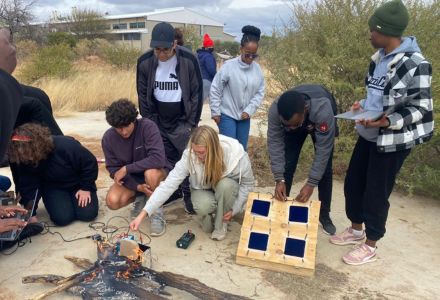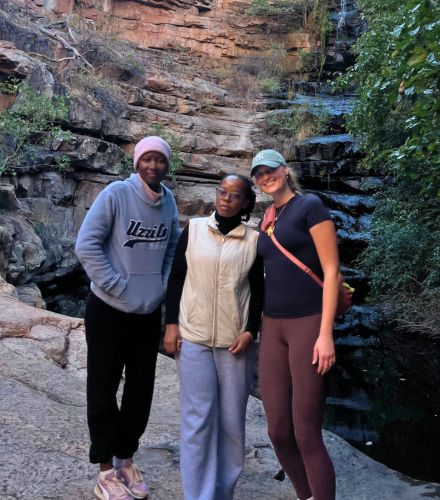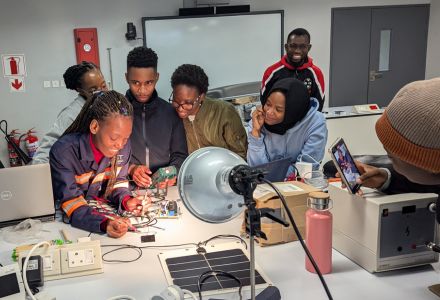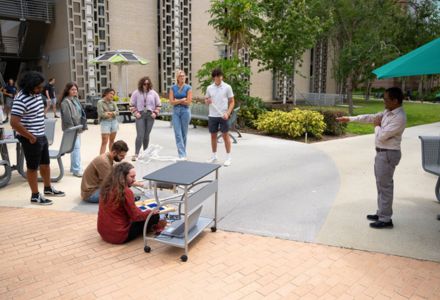Supported by a National Science Foundation (NSF) grant, researchers from USF’s College of Arts and Sciences Department of Physics have been engaged in a multi-year project to develop a portable, renewable energy source specifically designed for the needs of rural African communities.

USF students demonstrating the solar cell enhancements with BIUST students. (Photo courtesy of Madison Orr)
“Most rural villages in Africa lack basic infrastructure to bring electricity to their
villages. Portable sources are the best solution for them and they welcome these efforts
to improve their lives,” Dr. Sarath Witanachchi, chair and professor, explained.
“The primary goal of this NSF-sponsored project is to explore a new concept that combines
solar cells and waste heat to develop a portable, renewable energy source [for rural
Africa].”
Waste heat is produced as a byproduct of energy-using processes. With coal being one of Botswana’s primary energy sources, Witanachchi and his team dedicated their spring semester to learning how to convert heat into thermoelectric energy. This would boost the power output of the solar cells, enhancing the efficiency of these clean energy sources.
After the spring semester concluded, the researchers packed their bags to apply their knowledge in the real world and share their insights with students at the Botswana International University of Science and Technology (BIUST), creating an unforgettable learning experience.
“One primary objective was proving the concept of combining solar energy and thermoelectric energy to increase the effectiveness of renewable energies in rural areas ─ which were highly prominent in the areas we visited,” Joshua Townsend, PhD student and lead researcher of the group, explained. “Our other objective was to facilitate these research objectives in a multicultural and multidisciplinary setting. This allowed USF students to learn the project and use this knowledge to teach and collaborate with students in Botswana while being submersed in their culture and day-to-day activities.”
In addition to establishing daily goals and gathering data in the lab, the students were able to spend a lot of free time with BIUST colleagues to learn more about life in Botswana.

Biology student Madison Orr (left) with BIUST students Boitumelo Gaolape and Kago Mashabe. (Photo courtesy of Madison Orr)
“The highlight of my time at BIUST was definitely building a rapport with the BIUST students. I immediately bonded with another student, Kago, over volleyball, and after that first interaction, we became good friends,” said biology major Madison Orr.
This experience left students with respect for their Batswanan colleagues’ flexibility in applying their research with limited resources and an appreciation for the resources we have available to us stateside.
“At U.S. universities, we take advantage of the quick and easy Amazon Prime delivery or shops that are just down the street for materials, but in Botswana, there was no quick and easy access, so it brought up additional problems to solve,” Orr explained. “We had to learn the importance of delegation and to find a role for everyone that suits their niche.”
Students also returned home with a new understanding of applied physics.
“The most rewarding part of working on this project was being able to teach the students
at BIUST with hands-on experience. I had never realized how much USF offers students
important teaching tools such as lab experiments and connecting physics theory back
to physical representations,” physics student Spencer Hernandez said.
“Working on this project has given me a better understanding of the expectations and setbacks that come with physics research,” said Kevin Gorgey. “As a physics major, we rarely get the opportunity to work with electrical systems in a practical sense outside of brief lab work so I feel like this experience has given me invaluable experience that will undoubtedly help with future career opportunities.”
Though this is the final phase of the four-year NSF grant, Witanachchi hopes to continue the tradition of instilling a deep respect for other cultures in a meaningful and applicable way for his students.
“So, we’ll continue,” he said. “We’ll go back to Africa, or maybe another country. I really look forward to providing these international research experiences for USF students. They really benefit from it.”

BIUST students applying the enhancements to the solar cell(s). (Photo courtesy of Sarath Witanachchi)

Dr. Witanachchi (right) instructing students testing solar cells outside ISA weeks before their trip to Botswana. (Photo by of Corey Lepak)